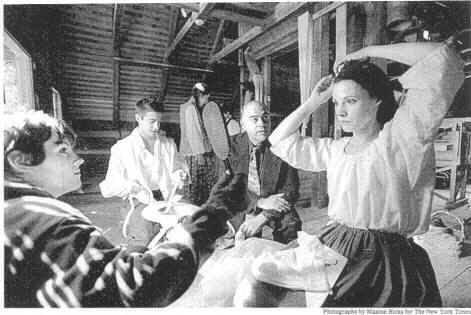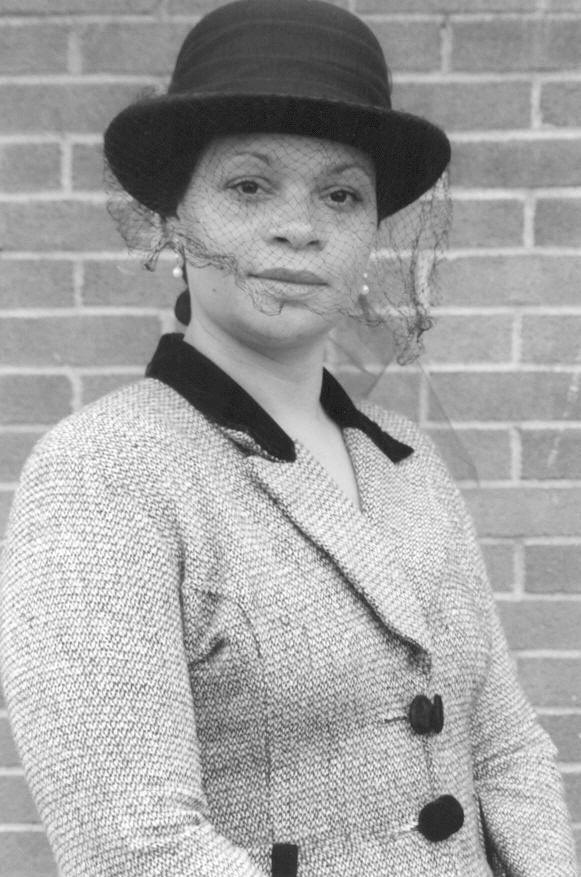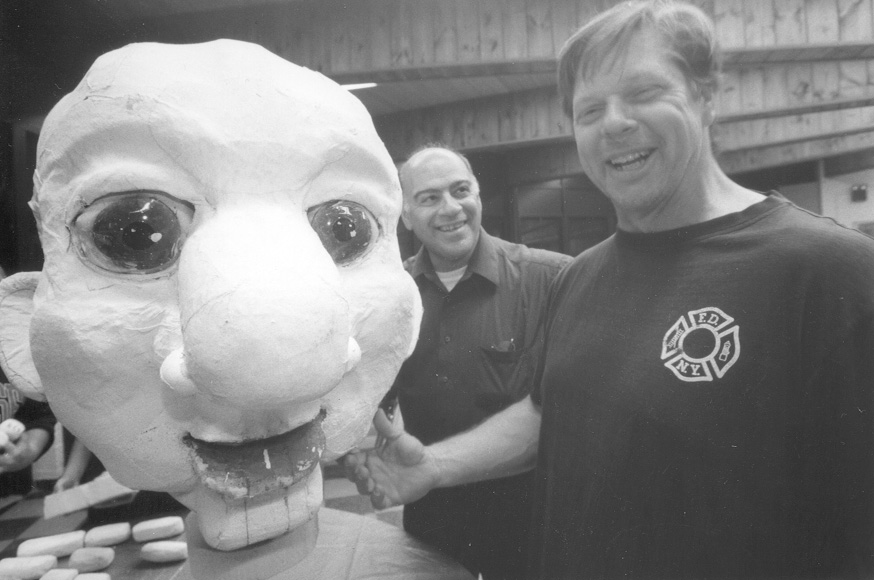|

By N.C. MAISAK

ugusta Gaynor, the grande dame of Deepwells,
is accustomed to receiving the world's rich and famous. After all, at
one time or another, John Barrymore, Fanny Brice, Coco Chanel, Annie
Oakley, Mary Pickford, Harry Houdini, Mae West and Madam C.J. Walker
have sat down in her elegant Victorian parlor for a cup of tea.
But here most important guest, the one who seems to have charmed
Isable, her imperturbable maid, is Sal St. George.
Who?
"Sal St. George? You've never heard of Sal
St. George?" Isabel says. "That's and outrage. Why, the man's a saint
in every sense of his name."
The setting is a rehearsal for the holiday
show that will run through Dec. 29. at Deepwells, the real-life Gaynor
home in St. James, and Mr. St. George, 51, is the creator of this
90-minute historical re-creation and hundreds of others like it.
"I'm very passionate about the idea of
taking history and making it come to life." said Mr. St. George, whose
company, St. George Productions, is based in Medford. "We jokingly call
it 'Sesame Street' for adults."
"You are not just an observer," Mr. St.
George added involved in every moment. The audience comes in, they are
laughing, they are crying, we provoke them. We challenge them
intellectually. Emotionally. But most important, they are thinking.
And when they leave, all we want to hear them say is, 'Oh, I didn't know
that'."
And through unforgettable characters like
Mrs. Gaynor, the wife of William J. Gaynor, the mayor of New York form
1910 to 1913. Although Mrs. Gaynor, who owned Deepwells, a fie-bedroom
Victorian farmhouse, form 1905 to 1919, is a historical figure, her
wisecracking sidekick Isabel is purely a St. George creation (he has
never given her a last name).
Mr. St. George's shows get people to come
to museums, and they also get them to come back. One loyal fan, for
instance, recently saw three of his productions all in one day: a Civil
War drama at the Stony Brook Grist Mill, a musical about the 1939
World's Fair at the Vanderbilt Museum in Centerport and an Annie Oakley
biography at Deepwells. His shows have also been produced at Rock Hall
Museum in Lawrence, the Big Duck in Flanders, the Long Island Game Farm
Wildlife Park in Manorville and the annual Dickens Festival in Port
Jefferson.
"Sal's shows are a totally transporting
experience," said Lance Mallamo, the executive director of the
Vanderbilt. he said that attendance there had increased 15 percent in
the last four years in large part because of Mr. St. George's shows.
The shows tell history as it was, even if
it means touching on controversial subjects. For instance, when Mr.
St. George produced a show about Madam C.J. Walker, whose hair-care
products made her the first black woman in the United States to become a
self-made millionaire, he did not dodge the issue of racial
discrimination.
"I went to the African-American community
and asked them what they and their parents and grandparents remembered
about the little subtle things that were done to them," he said. "one
thing they remembered was that whites didn't shake hands with them
because they were afraid the color would rub off on them."
To get this point across in the show, Mr.
St. George had the ailing Madam Walker wipe her brow with a cold cloth.
When Isabel, the maid, takes the cloth away on a tray, she lifts up a
corner just to see whether it is, indeed, black underneath.
"Some of the whites in the audience were
uncomfortable with this scene," Mr. St. George said, "and there was some
discomfort level from the actresses, who wondered whether we were going
to offend, but the blacks in the audience told me that they were
appreciative because we represented the past in a honest way. That show
was four years ago, and we're still getting calls about it."
For each show, Mr. St. George does extensive
research on the setting and the characters.
"We try to get some kind of Long Island
connection," he said. "long Island is rich with history. We know, for
instance, that Mrs. Gaynor, who was wealthy, would have entertained many
of the famous people who came to Long Island, so we checked the town
registries and use that information to connect her with them."
Showgoers are drawn to Mr. St. George's
attention to historic detail, said Richard Martin, the director of
historic services for Suffolk County Parks, which owns Deepwells.
"Once people see Sal's shows they are sold
on them right away," he said, adding that at Deepwells alone, "we have a
15,000-person mailing list, and the word just keeps
spreading."
Mr. St. George's own history is every bit
a s rich as that of his characters. At his office in Medford, he has
bookshelves filled with biographies, which he has been collecting since
childhood. When he was a student at Adelphi University, he wrote a
research paper on Abbott and Costello and managed to track down Bud
Abbott, who invited him to visit him in Los Angeles. Mr. St. George
went during his January semester break, intending to stay for three
days. He didn't leave for three weeks because he was having so much fun
meeting Mr. Abbott's friends, people like the Andrews Sisters, Steve
Allen and Joe Besser, one of the Three Stooges.
He became intrigued by Hollywood as it
once was, and in 1983 he created "Frontier Follies," an old time
vaudeville show. It toured the country for 14 years, and "people kept
coming up to me and telling me, 'That's just the way I remember the
shows for the 1920's and 30's," he said.
In 1991, he then became a consultant to
theme parks, writing, directing and producing shows for Walt Disney
World, Busch Gardens, Silver Dollar City in Branson, Mo., and more
recently for Colonial Williamsburg and Historic Philadelphia.
By 1995, he was creating Long Island
shows, and before he knew it, St. George Productions had become a family
affair. His wife, Mary, handles the business end, and his two children,
he 10-year-old daughter, Dana, and 15-year-old son, Darren, sometimes
act in his shows.
"My goal is to do a program at every
historic site on Long Island," said Mr. St. George, a Manhattan native
who moved to Long Island as a teenager. "Whereas several years ago
it was appropriate to walk into a museum and
see a desk and say this is the desk that Benjamin Franklin sat at and he
wrote his notes here, now people would rather see Benjamin Franklin
sitting at that desk and hear, in his own words, what inspired him to
write those notes. That's what we do, and we're breaking new ground by
doing it."
Eventually, Mr. St. George hopes to create
a two-hour spectacular that chronicles Long Island's history form the
ice age to the space age.
"After all these years, I still love doing
this," he said. "Everybody's life is intriguing. I can't understand why Hollywood feels
the need to alter history to quote-unquote make it more dramatic when
real life is so much more intriguing. Why change history?"
I'm
very passionate about the idea of taking
history and making it come to life," said Sal St. George, creator of
hundreds of historical vignettes, many of them at Long Island sites.
Mr. St. George, in suit and tie, meets with actors in his show at Stony
Brook Grist Mill.
top



|

